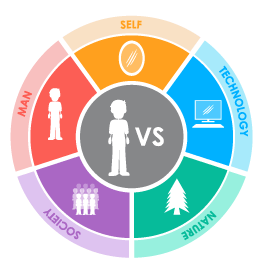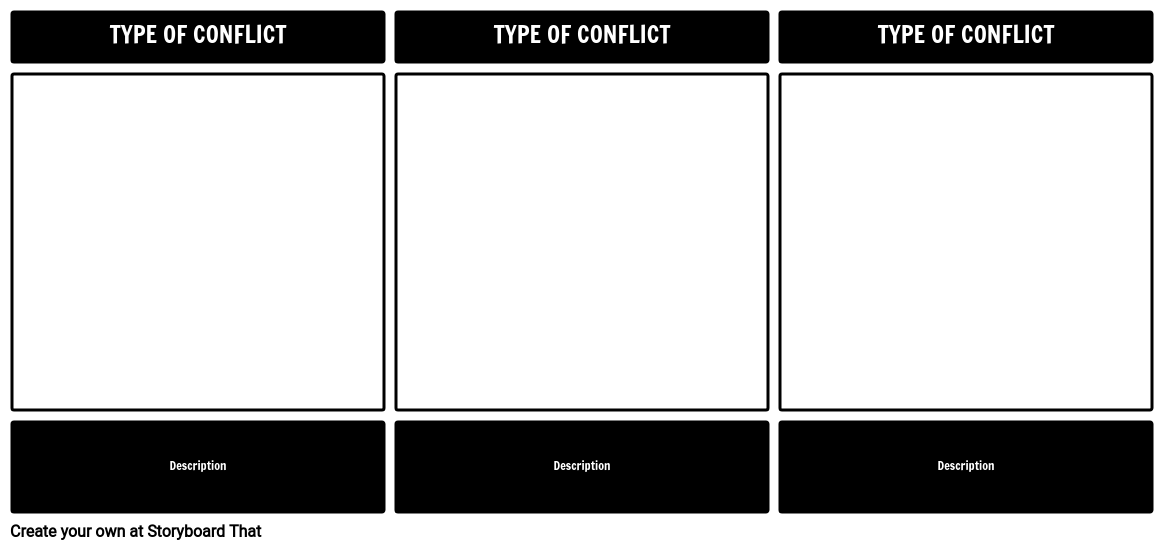Lesson Plan Overview
Storyboarding is an excellent way to focus on types of literary conflicts. Having students create storyboards that show the cause and effect of different types of conflicts strengthens analytical thinking about literary concepts. Have your students choose an example of each literary conflict and depict them using the Storyboard Creator. In the storyboard, an example of each conflict should be visually represented, along with an explanation of the scene, and how it fits the particular category of conflict.
In Frankenstein, much of the conflict stems from the resentment and rejection that the monster feels from society. Chapter by chapter, Frankenstein's monster grows more hateful of his creator and turns to murder to release his anger and enact his revenge.
Examples of Literary Conflict in Frankenstein
MAN vs. MAN (MONSTER): Frankenstein vs. His Creation
As the creatures' feelings of rejection and bitterness grow towards his creator, the monster uses murder to make Frankenstein pay for what he has done.
MAN vs. NATURE: Frankenstein Creating Life
Victor bringing his creation to life violates the laws of nature. When he is asked to repeat the process, he denies the monster by destroying the monster’s bride.
MAN vs. SOCIETY: Monster vs. Society
Rejected because he is hideous, society banishes the monster and he becomes an outcast.
Template and Class Instructions
(These instructions are completely customizable. After clicking "Copy Activity", update the instructions on the Edit Tab of the assignment.)
Student Instructions
Create a storyboard that shows at least three forms of literary conflict in Frankenstein.
- Identify conflicts in Frankenstein.
- Categorize each conflict as Character vs. Character, Character vs. Self, Character vs. Society, Character vs. Nature, or Character vs. Technology.
- Illustrate conflicts in the cells, using characters from the story.
- Write a short description of the conflict below the cell.
Lesson Plan Reference
Student Rubric
(You can also create your own on Quick Rubric.)
| Proficient | Emerging | Beginning | Try Again | |
|---|---|---|---|---|
| Conflict Identification | Student identifies correct major conflicts and uses strong, clear textual evidence to support choice. | Student identifies correct major conflict and uses few or unclear details to support their choice. | Student identifies incorrect major conflict, and uses some details from the text to support their choice. | Student does not attempt to identify major conflict or identifies incorrect major conflict with no explanation. |
| Understanding Outcome | Student clearly shows the outcome of the conflict and its effects on the protagonist with evidence from the text. | Student shows the outcome of the conflict and its effect on the protagonist, but some evidence is unclear. | Student shows the outcome of the conflict, but does not examine its effect on the protagonist and uses some vague textual evidence. | Student does not clearly show the outcome of the conflict or use textual evidence. |
| Character | Storyboard includes all required characters and clearly names them. Goes above and beyond by adding additional details. | Storyboard includes all required characters and clearly names them. | Storyboard includes protagonist and antagonist but leaves out other required characters. | Storyboard does not include the names of required characters. |
| Storyboard | Student clearly shows effort to convey the setting the scene of the book | Student attempts to convey setting and scene of the book, but lacks some clarity. | Student does not clearly convey the setting and scene. | Student makes little or no attempt to convey the setting or scene. |
| Spelling and Grammar | Student uses exemplary spelling and grammar. There are no errors. | Student makes a minor error in spelling and grammar. | Student makes several minor errors in spelling and grammar. | Student makes many errors in spelling and grammar; little attempt at spellchecking. |
Lesson Plan Overview
Storyboarding is an excellent way to focus on types of literary conflicts. Having students create storyboards that show the cause and effect of different types of conflicts strengthens analytical thinking about literary concepts. Have your students choose an example of each literary conflict and depict them using the Storyboard Creator. In the storyboard, an example of each conflict should be visually represented, along with an explanation of the scene, and how it fits the particular category of conflict.
In Frankenstein, much of the conflict stems from the resentment and rejection that the monster feels from society. Chapter by chapter, Frankenstein's monster grows more hateful of his creator and turns to murder to release his anger and enact his revenge.
Examples of Literary Conflict in Frankenstein
MAN vs. MAN (MONSTER): Frankenstein vs. His Creation
As the creatures' feelings of rejection and bitterness grow towards his creator, the monster uses murder to make Frankenstein pay for what he has done.
MAN vs. NATURE: Frankenstein Creating Life
Victor bringing his creation to life violates the laws of nature. When he is asked to repeat the process, he denies the monster by destroying the monster’s bride.
MAN vs. SOCIETY: Monster vs. Society
Rejected because he is hideous, society banishes the monster and he becomes an outcast.
Template and Class Instructions
(These instructions are completely customizable. After clicking "Copy Activity", update the instructions on the Edit Tab of the assignment.)
Student Instructions
Create a storyboard that shows at least three forms of literary conflict in Frankenstein.
- Identify conflicts in Frankenstein.
- Categorize each conflict as Character vs. Character, Character vs. Self, Character vs. Society, Character vs. Nature, or Character vs. Technology.
- Illustrate conflicts in the cells, using characters from the story.
- Write a short description of the conflict below the cell.
Lesson Plan Reference
Student Rubric
(You can also create your own on Quick Rubric.)
| Proficient | Emerging | Beginning | Try Again | |
|---|---|---|---|---|
| Conflict Identification | Student identifies correct major conflicts and uses strong, clear textual evidence to support choice. | Student identifies correct major conflict and uses few or unclear details to support their choice. | Student identifies incorrect major conflict, and uses some details from the text to support their choice. | Student does not attempt to identify major conflict or identifies incorrect major conflict with no explanation. |
| Understanding Outcome | Student clearly shows the outcome of the conflict and its effects on the protagonist with evidence from the text. | Student shows the outcome of the conflict and its effect on the protagonist, but some evidence is unclear. | Student shows the outcome of the conflict, but does not examine its effect on the protagonist and uses some vague textual evidence. | Student does not clearly show the outcome of the conflict or use textual evidence. |
| Character | Storyboard includes all required characters and clearly names them. Goes above and beyond by adding additional details. | Storyboard includes all required characters and clearly names them. | Storyboard includes protagonist and antagonist but leaves out other required characters. | Storyboard does not include the names of required characters. |
| Storyboard | Student clearly shows effort to convey the setting the scene of the book | Student attempts to convey setting and scene of the book, but lacks some clarity. | Student does not clearly convey the setting and scene. | Student makes little or no attempt to convey the setting or scene. |
| Spelling and Grammar | Student uses exemplary spelling and grammar. There are no errors. | Student makes a minor error in spelling and grammar. | Student makes several minor errors in spelling and grammar. | Student makes many errors in spelling and grammar; little attempt at spellchecking. |
How Tos about Examining Literary Conflict in Frankenstein
Organize a classroom debate on Frankenstein’s major conflicts
Encourage students to take sides on key conflicts from Frankenstein and argue their perspectives. Debates help learners analyze characters’ motivations and develop critical thinking skills.
Select compelling conflict scenarios from the text
Choose dramatic moments that show different types of conflict, such as Frankenstein’s struggle with his creation or the monster’s fight against society. This makes the debate engaging and grounded in the novel.
Assign student roles and perspectives
Divide your class into groups, each representing a different character or viewpoint. Assign roles like Victor Frankenstein, the Monster, or Society to encourage empathy and deeper understanding.
Guide research and evidence gathering
Have students find quotes and scenes that support their arguments. Using textual evidence strengthens reasoning and keeps the debate focused on Frankenstein.
Facilitate respectful, structured debate
Set clear rules for taking turns, addressing counterarguments, and supporting claims. This fosters a positive environment where students can express ideas confidently and listen to peers.
Frequently Asked Questions about Examining Literary Conflict in Frankenstein
What are the main types of literary conflict in Frankenstein?
Frankenstein features several key types of literary conflict, including Character vs. Character (Victor Frankenstein vs. his creation), Character vs. Society (the monster's rejection by people), and Character vs. Nature (Victor defying natural laws by creating life). Understanding these conflicts helps students analyze the story's deeper themes.
How can I teach literary conflict using storyboards with Frankenstein?
To teach literary conflict with storyboards, have students identify examples of conflict in Frankenstein, such as man vs. man or man vs. society. Students then visually depict each conflict scene and add short explanations, reinforcing both comprehension and analytical skills.
What is an example of Character vs. Society conflict in Frankenstein?
An example of Character vs. Society in Frankenstein is the monster being rejected and feared by society because of his appearance. This rejection shapes his actions and feelings, making it a central conflict in the novel.
Why is exploring conflict important in teaching Frankenstein to students?
Exploring conflict in Frankenstein helps students understand character motivations, plot development, and broader themes like isolation and responsibility. It also strengthens critical thinking and literary analysis skills.
What are some creative ways to help students analyze conflict in Frankenstein?
Creative strategies include having students create storyboards, role-play key scenes, or write journal entries from a character's perspective. These activities make analyzing conflict in Frankenstein more engaging and meaningful.
More Storyboard That Activities
Frankenstein
Testimonials

“By using the product, they were so excited and they learned so much...”–K-5 Librarian and Instructinal Technology Teacher

“I'm doing a Napoleon timeline and I'm having [students] determine whether or not Napoleon was a good guy or a bad guy or somewhere in between.”–History and Special Ed Teacher

“Students get to be creative with Storyboard That and there's so many visuals for them to pick from... It makes it really accessible for all students in the class.”–Third Grade Teacher
© 2026 - Clever Prototypes, LLC - All rights reserved.
StoryboardThat is a trademark of Clever Prototypes, LLC, and Registered in U.S. Patent and Trademark Office








